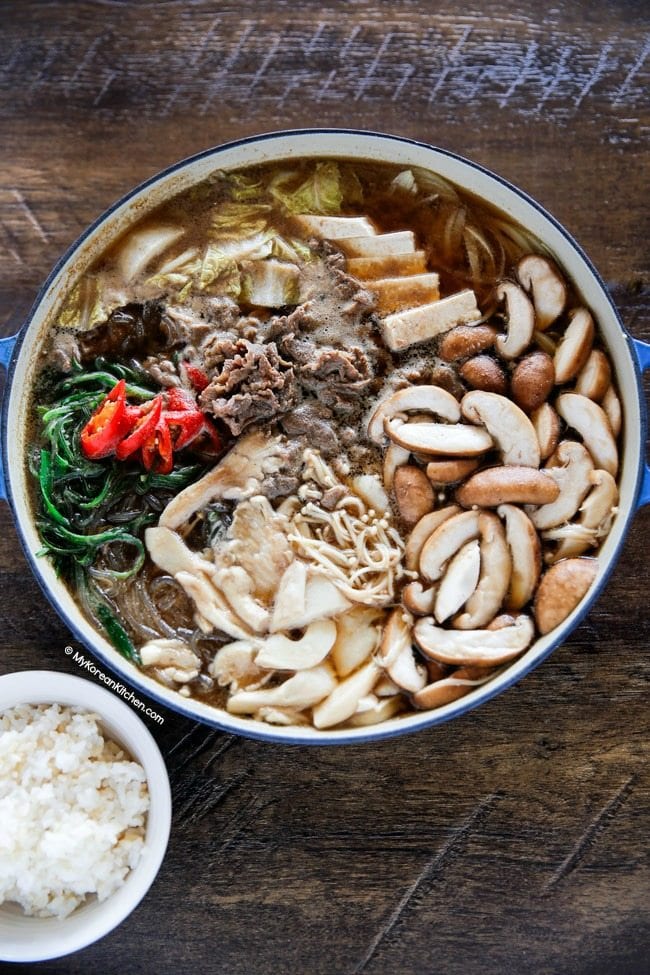Indulge your taste buds with the tantalizing flavors of Korean cuisine.
Imagine tender, succulent short ribs simmered to perfection in a rich and aromatic broth.
This is Korean beef stew, a dish that effortlessly combines the best of traditional Korean ingredients with slow cooking techniques.
Served alongside fluffy rice, tangy kimchi, and fragrant scallions, it’s a culinary experience that will transport you to the vibrant streets of Seoul.
Come, join us on a gastronomic adventure and discover the wonders of Korean beef stew.
korean beef stew
Korean beef stew is a delicious and flavorful dish that combines classic Korean ingredients such as spicy chili paste, garlic, Korean soy sauce, sesame oil, and rice wine.
The stew is slow-cooked with short ribs, resulting in a rich and meaty flavor.
It is often served with rice, kimchi, and grilled spring onions as side dishes.
If gochujang, the Korean fermented chili paste, is not available, a substitute can be made using red chili pepper flakes, soy sauce, and sugar.
Overall, Korean beef stew is a hearty and satisfying meal that showcases the flavors of Korean cuisine.
Key Points:
- Korean beef stew combines spicy chili paste, garlic, Korean soy sauce, sesame oil, and rice wine for a delicious and flavorful dish.
- The stew is slow-cooked with short ribs to create a rich and meaty flavor.
- It is commonly served with rice, kimchi, and grilled spring onions as side dishes.
- If gochujang is not available, a substitute can be made using red chili pepper flakes, soy sauce, and sugar.
- Overall, Korean beef stew is a hearty and satisfying meal.
- It is a great way to experience the flavors of Korean cuisine.
korean beef stew – Watch Video
💡
Pro Tips:
1. Korean beef stew, also known as “Galbijjim,” is a popular traditional dish made with beef short ribs.
2. The dish originated from royal cuisine in the Joseon Dynasty and was considered a delicacy among the upper class.
3. Galbijjim is slow-cooked, allowing the flavors to meld together and the meat to become tender and succulent.
4. It often includes various ingredients such as carrots, potatoes, mushrooms, and chestnuts, all adding their unique flavors and textures to the dish.
5. To enhance the taste, Galbijjim is traditionally seasoned with soy sauce, sesame oil, ginger, and other aromatic spices, creating a rich and savory flavor profile.
1. Classic Korean Flavors In Beef Stew
Korean beef stew is a delightful dish that showcases the classic flavors of Korea. This hearty stew is made with a combination of spicy chili paste, garlic, Korean soy sauce, sesame oil, and rice wine. These ingredients come together harmoniously to create a complex and mouth-watering flavor profile. The stew embodies the bold and dynamic taste that is characteristic of Korean cuisine.
2. Rich And Flavorful Broth
The Korean beef stew is known for its deep and rich flavor. The slow cooking process, especially with the bone-in, enhances the intensity and perfect blending of flavors. As a result, a luscious and fragrant broth is created, infused with hints of nuts, spice, and a touch of sweetness from the rice wine. The addition of fermented chili paste and soy sauce contributes to the stew’s robust umami flavor, elevating the overall taste experience.
- The Korean beef stew has a deep and rich flavor.
- Slow cooking process with bone-in intensifies and melds flavors.
- Luscious and fragrant broth infused with hints of nuts, spice, and sweetness from rice wine.
- Fermented chili paste and soy sauce add robust umami flavor.
3. The Key To Tender Meat: Braising
One of the secrets to achieving tender and melt-in-your-mouth meat in Korean beef stew is through the process of braising. Braising involves slowly cooking the beef in a liquid, which helps break down the tough fibers and results in a tender and succulent meat texture.
This cooking technique allows the flavors of the beef to infuse with the stew, creating a truly delightful culinary creation.
- Braising is the key to tender meat in Korean beef stew
- Slowly cooking beef in a liquid breaks down tough fibers
- Results in a tender and succulent meat texture
- Flavors of the beef infuse with the stew
4. Adding Vegetables For Extra Goodness
Some variations of Korean beef stew include the addition of vegetables towards the end of the cooking process. This not only adds vibrant colors to the dish but also contributes to its nutritional value. Vegetables such as carrots and sweet potatoes lend their natural sweetness and textures to the stew, enhancing the overall flavor and providing a delightful contrast to the meat.
5. Choosing The Right Cuts Of Beef
To ensure the best results, it is recommended to use high-quality short ribs with less fat for the Korean beef stew recipe. The leaner ribs will provide a healthier and more balanced dish. When selecting the beef, look for cuts that are marbled, as this will enhance the richness and tenderness of the meat. The quality of the beef plays a significant role in the overall taste and texture of the stew.
6. Gochujang: The Magic Ingredient
Korean fermented chili paste, known as gochujang, plays a vital role in Korean beef stew. Gochujang is created by blending red chili, glutinous rice, fermented soybeans, and salt. This remarkable ingredient enriches the stew with a delightful combination of sweetness and savory umami flavor. It is a staple in Korean cuisine, lending a distinctive taste that sets Korean beef stew apart from other variations.
7. Sweet And Savory Umami With Gochujang
The inclusion of gochujang in Korean beef stew brings a remarkable balance of sweet and savory flavors. The umami taste, derived from the fermentation process of the soybeans and chili, creates a depth of flavor that perfectly complements the richness of the meat. Gochujang adds a hint of spiciness, which gives the dish an exciting kick without overpowering the other flavors. It is the secret ingredient that takes the stew to a whole new level.
- Gochujang brings a remarkable balance of sweet and savory flavors to Korean beef stew.
- The fermentation process of soybeans and chili creates an umami taste.
- The depth of flavor from gochujang complements the richness of the meat.
- Gochujang adds a hint of spiciness without overpowering the other flavors.
- The secret ingredient that takes the stew to a whole new level.
8. Gochujang Substitute: DIY Version
If gochujang is not readily available, fear not! A substitute version can be easily made by blending red chili pepper flakes with soy sauce and sugar. While this may not replicate the exact flavor profile of gochujang, it will provide a similar level of spiciness, sweetness, and umami that is essential to the overall taste of the Korean beef stew. This homemade alternative allows you to enjoy the dish even if you don’t have access to authentic gochujang.
- Blending red chili pepper flakes with soy sauce and sugar can create a substitute version of gochujang
- The homemade alternative provides similar spiciness, sweetness, and umami
- It is essential to the overall taste of the Korean beef stew
- Enjoy the dish even without authentic gochujang.
9. Perfect Pairings: Rice, Kimchi, And Spring Onions
Korean beef stew is usually served with several tasty side dishes that complement its flavors. Here are some ways to enhance your experience when enjoying this dish:
-
Steamed rice: Pairing the stew with steamed rice allows you to fully appreciate the flavorful broth and tender beef.
-
Kimchi: The spicy and tangy flavors of kimchi create a delightful contrast to the stew, enhancing its overall taste.
-
Grilled spring onions: Adding grilled spring onions to the meal provides a refreshing crunch, creating a satisfying balance.
Remember to savor each bite and enjoy the combination of flavors in this delicious Korean dish.
10. Ingredients And Cooking Instructions
To prepare Korean beef stew, you will need the following ingredients:
- 3 lbs (1.3 kg) of lean short ribs
- Vegetable oil
- Beef stock
- Korean soy sauce
- Rice wine
- Apple juice
- Gochujang (Korean fermented chili paste)
- Sesame oil
- Garlic
- Onion
- Salt
- Pepper
- Carrots
- Sweet potatoes
The cooking instructions involve:
- Salting and peppering the short ribs.
- Browning them in a pot with vegetable oil.
- Meanwhile, whisk together the stock, soy sauce, wine, chili paste, apple juice, sesame oil, garlic, and onion.
- Add the sauce to the pot with the short ribs and simmer for approximately 2 hours to allow the flavors to infuse.
- Afterward, add sweet potatoes and carrots, and simmer for another 1/2 hour until the vegetables are tender.
- Serve the stew with kimchi, rice, and grilled spring onions for a complete and satisfying meal.
Korean beef stew is a dish that showcases the classic flavors of Korea. The combination of spicy chili paste, garlic, soy sauce, sesame oil, and rice wine creates a deep and rich flavor profile. Braising the beef ensures tender and succulent meat, while the addition of vegetables adds extra goodness. Gochujang, the magic ingredient, provides a sweet and savory umami taste that elevates the stew to new heights. Whether enjoyed with rice, kimchi, or spring onions, Korean beef stew is a truly delightful culinary experience.
💡
You may need to know these questions about korean beef stew
What is Korean beef stew made of?
Korean beef stew is a delectable dish made by braising short ribs with a tantalizing sauce. This flavorful sauce combines the heat of spicy Korean chili paste, the richness of sesame oil, and the subtle sweetness of rice wine. As the meat simmers in this aromatic concoction, it transforms into a tender masterpiece, creating a thick and hearty stew that showcases the iconic tastes of Korean cuisine.
What is stew in Korea?
In Korea, stew, known as jjigae, is a popular and versatile dish with numerous variations. Jjigae is a type of stew made with a rich broth and ingredients like meat, seafood, or vegetables, which are typically seasoned with gochujang, doenjang, ganjang, or saeu-jeot. The use of these traditional Korean condiments adds depth and flavor to the stew, creating a satisfying and delicious meal. Whether it is a comforting kimchi jjigae or a spicy and hearty sundubu jjigae, Korean stews are cherished for their complex flavors and the ability to warm both the body and the soul.
Why is Korean beef so good?
Korean beef stands out for its exceptional quality due to several factors. First and foremost, the Hanwoo cattle are carefully raised in the South Korean countryside, where they roam freely and graze on a diet consisting of organic mixed grains and grass. This upbringing results in beef with a high marbling content, lending it a rich and succulent flavor. Additionally, Hanwoo beef has a slight sweetness to its taste, further enhancing its overall appeal. Given the meticulous rearing methods and superior flavor, it comes as no surprise that Korean beef, particularly Hanwoo, is highly regarded and accordingly priced in South Korea.
Are Korean stews healthy?
Yes, Korean stews like Dakdoritang are a healthy choice as they combine lean proteins such as chicken with a variety of nutrient-rich vegetables. The braising process retains the flavors and nutrients of the ingredients, making the stew rich in vitamins and minerals. Additionally, the spicy sauce adds a kick of flavor, boosting metabolism and promoting digestion. So not only is Dakdoritang a flavorful and heartwarming dish, but it also contributes to a balanced and healthy diet.
Reference source
https://www.venturists.net/korean-beef-stew-recipe-korean-short-ribs/
https://en.wikipedia.org/wiki/Jjigae
https://www.allrecipes.com/recipe/273203/korean-beef-stew/
https://www.tasteofhome.com/article/how-to-make-tough-meat-tender/



